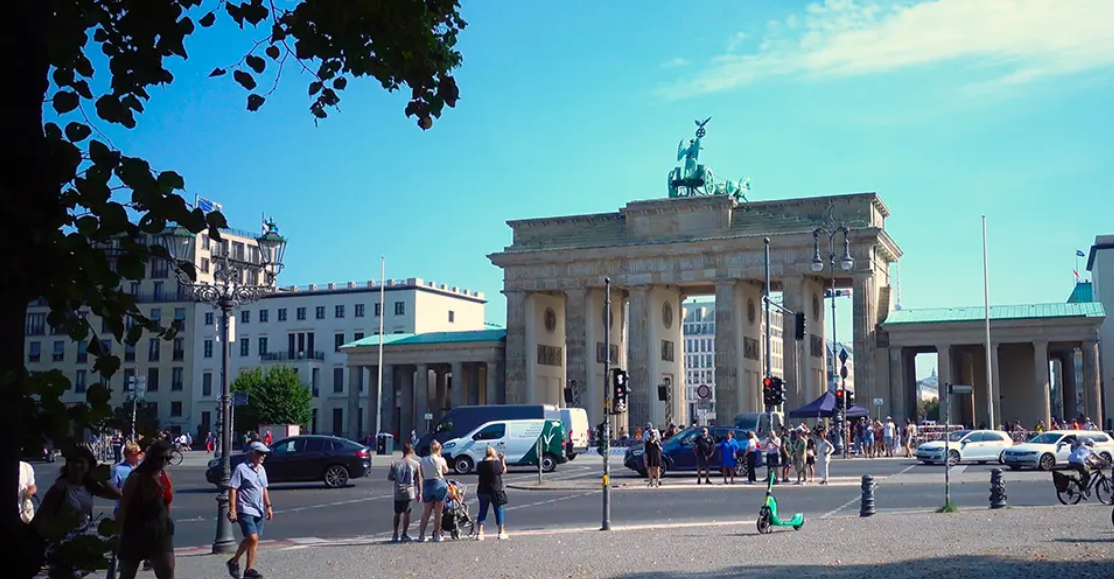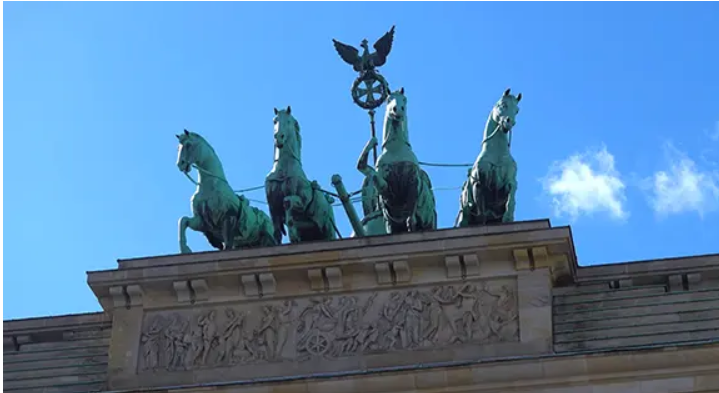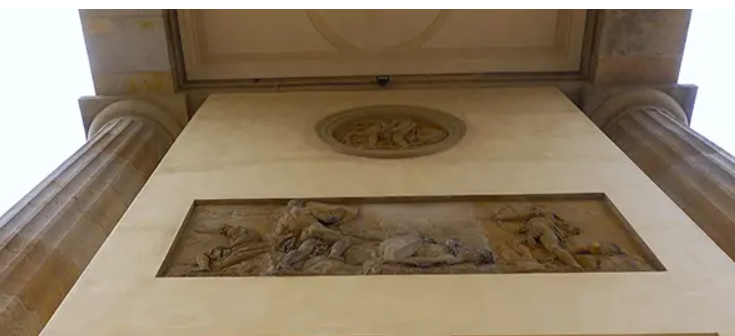Triumphal Gate on Pariser Platz
Address: Brandenburg Gate, Pariser Platz 5, 10117 Berlin | Built: 1789 to 1793 | Architectural style: Neoclassical | Height: 26 m
The Brandenburg Gate is a spectacular sight with a rich history and an important landmark of Berlin. It is the only city gate in the metropolis that has defied many adversities and represents a reflection of German history. The Brandenburg Gate was once an important symbol of the city’s division into West and East.
Today, it symbolizes the reunification of Germany after the fall of the Berlin Wall. Built of sandstone, the Brandenburg Gate is one of the most beautiful neoclassical buildings in Germany.
Directions and Location of the Berlin Landmark
The Brandenburg Gate stands in the heart of Berlin on Pariser Platz. It is one of the most beautiful squares in Berlin. Strolling along the boulevard “Unter den Linden” automatically leads to Pariser Platz and the Brandenburg Gate. From the other side, the “Straße des 17. Juni” leads directly to the monumental structure. Numerous impressive buildings cluster around the landmark, including the US Embassy, the Hotel Adlon Kempinski, and the Berlin University of the Arts.
Traffic is diverted around the Brandenburg Gate. The square itself is at ground level and has no stairs or barriers, allowing every visitor, even those with physical disabilities, to reach the Brandenburg Gate.
Opening Hours and Tours
The Brandenburg Gate can be visited at any time. A visit at night, when the structure is illuminated by large floodlights, is particularly impressive. However, anyone wishing to visit the “Room of Silence” in the Brandenburg Gate must note the current opening hours:
Brandenburg Gate Opening Hours
March to October
11:00 AM – 6:00 PM
November
11:00 AM – 5:00 PM
December to January
11:00 AM – 4:00 PM
February
11:00 AM – 5:00 PM

Brandenburg Gate Admission Prices
The Brandenburg Gate is a publicly accessible building. No ticket is required, and therefore there are no admission fees.
Guided Tours of the Brandenburg Gate
Special guided tours of the Brandenburg Gate itself are not offered. Those interested in learning more about the building and the history of Berlin should download the free “About Berlin” app to their smartphone. It is available for both Apple iPhones and Android smartphones. The app immerses users in the history of the landmark and contains numerous, sometimes even unknown, stories about the Brandenburg Gate and other landmarks.
FAQ – Frequently Asked Questions about the Brandenburg Gate
When was the Brandenburg Gate built?
The Brandenburg Gate was built between 1788 and 1791 during the reign of King Frederick William II of Prussia.
What is the significance of the Brandenburg Gate?
The Brandenburg Gate is a symbolic structure that stands for unity and freedom. Originally built as part of the Berlin Customs Wall, today it symbolizes the overcoming of the division of Germany and Europe. As a landmark of Berlin, the Brandenburg Gate is an important symbol of peace, unity, and freedom.
How tall is the Brandenburg Gate?
The Brandenburg Gate is approximately 26 meters tall.
On which side was the Brandenburg Gate located after the construction of the Berlin Wall?
After the construction of the Berlin Wall in 1961, the Brandenburg Gate was located in the so-called “death strip” between East and West Berlin and was not accessible to the public. It was a symbol of division and stood on East Berlin territory, while West Berlin citizens could only view it from a distance.
Is it possible to drive through the Brandenburg Gate by car?
Driving through the Brandenburg Gate by car is not possible, as the gate is closed to vehicle traffic and is only accessible to pedestrians and cyclists.
Why does the quadriga on the Brandenburg Gate face east?
The quadriga on the Brandenburg Gate, a triumphal carriage, faces east, as this was historically the direction of the royal entry into the city. This orientation also symbolizes Prussia’s expansion of power to the east, especially during the Napoleonic Wars and the subsequent Wars of Liberation. Furthermore, the eastward orientation underscores Berlin’s historical significance as a gateway to Eastern Europe.
Brandenburg Gate – Special Features and Interesting Facts
Strolling along Unter den Linden, you’ll see the Brandenburg Gate with its quadriga rising into the sky from afar. It is one of the most beautiful interpretations of classicism in Germany and, after the fall of the Berlin Wall, symbolized German reunification.
The architectural model for the Brandenburg Gate is the “Propylaea of the Acropolis” in Athens. The gigantic sandstone city gate rises 20.3 meters into the sky. Including the quadriga, it has a height of 26 meters. The impressive dimensions of the city gate are immediately apparent. The gate has a total width of 62.5 meters and a depth of 11 meters.
The height of each column measures 13.5 meters. The varying widths of the arches, which were formerly used as passageways, are striking.
The central passage for the royal carriage is 5.65 meters wide, while the ones to the right and left are only 3.80 meters wide.

The sandstone structure is dominated by six columns on either side. Unlike its classical counterpart, the Brandenburg Gate has a massive wall between the columns. The attic forms the top. Both there and in the wall between the columns are impressive reliefs depicting Hercules. The two gatehouses are decorated with sculptures of the goddess Minerva with her lance and Mars, the Roman god of war.
The two gatehouses at the Brandenburg Gate were originally intended for gate guards and tax collectors. In 1868, Schinkel’s student Heinrich Strack transformed the closed walls of the gatehouses into an open colonnade, adapting it to the gate.
Historical Facts and History of the Berlin Brandenburg Gate
Berlin owes the Brandenburg Gate to the last emperor and king, Frederick William II, who commissioned the exclusive building at the end of the magnificent boulevard “Unter den Linden.” The Brandenburg Gate was built between 1788 and 1791 according to the designs of Carl Gotthard Langhans.
The quadriga was not placed on the roof of the Brandenburg Gate until two years later. The quadriga depicts Victoria, the goddess of victory, whose chariot is drawn by four horses. The statue was a symbol of the peace that was coming to Berlin. After the Prussian defeat by France, Napoleon took the quadriga to Paris. Eight years later, the statue returned to Berlin and was placed back on the Brandenburg Gate.
During World War II, the quadriga, like the Brandenburg Gate, was badly damaged. Today, a reproduction adorns the Brandenburg Gate. A horse’s head from the original quadriga can be viewed in the Märkisches Museum.


The Brandenburg Gate has played a key role in German history not only since the construction of the Wall in 1961. It also had a symbolic significance in politics. In 1945, the Brandenburg Gate crowned the flag of the Soviet Union. It was known as the Peace Gate in the former GDR. With the construction of the Wall, the monumental building became a symbol of the division of Germany.
Ronald Reagan also made history in Berlin when, in his 1987 speech directly at the Wall, he called on Gorbachev to open the Brandenburg Gate and tear down the Wall. Two years later, on November 9, 1989, border guards opened a border crossing at the Brandenburg Gate, despite no official order to do so. After the restoration, which took about two years, the Brandenburg Gate now shines in new splendor and attracts numerous visitors to Berlin from all over the world every year.
Sights and attractions in the immediate vicinity of the Brandenburg Gate
In the immediate vicinity of the Brandenburg Gate lies not only the magnificent Unter den Linden boulevard. There are also true gems that are less prominent than the top sights.
Not far from the Brandenburg Gate is the Gendarmenmarkt. Anyone who goes there won’t know where to look first. It is one of the most beautiful squares in Berlin and is dominated by three unique buildings. Marvel at the German Cathedral, the French Cathedral, and the Concert Hall, which impressively frame the square.
At Friedrichstraße station, not far from the Brandenburg Gate, stands the so-called “Palace of Tears.” The building is a place of overwhelming emotions such as the pain of parting, fear, and anger. It clearly demonstrates the impact of the Cold War and the division of Berlin on life. On display there is, among other things, an original control booth that was used to process people at the border crossing.
Near the Palace of Tears is the Admiral Palace, a traditional venue. It is now considered the most important venue for cultural events such as theater performances, concerts, award ceremonies, and many other events.
Not far from the Brandenburg Gate is the Tiergarten. The park, with its large green spaces and numerous trees that provide shade in warm weather, is a beautiful place to relax, unwind, linger, and escape from the hustle and bustle of city life. While strolling through the park, visitors will encounter the carillon and the Soviet Memorial.
Cafés and Restaurants Near the Brandenburg Gate
Long walks and sightseeing tours are known to make you hungry and thirsty. It’s also always very pleasant to take in the interesting and exciting impressions in a cozy atmosphere. There’s a lovely selection of restaurants and cafés around the Brandenburg Gate.
ama Café
The ama Café is located on Dorotheenstraße, 500 meters from the Brandenburg Gate. In a cozy atmosphere, guests enjoy delicious coffee specialties, fresh cakes, and snacks such as tarte flambée or a delicious breakfast. The friendly and attentive service perfectly rounds off the visit.
Address: ama Café, Dorotheenstraße 83
Zucker & Zimt Kaffeehaus
The Zucker & Zimt Kaffeehaus on Schiffsbauerdamm is located 700 meters from the Brandenburg Gate. In addition to delicious coffee specialties, there is a tasty breakfast, a wide selection of cheeses, delicious waffles, and the menu also includes hot dishes to recharge your batteries in a pleasant coffee house atmosphere after a stroll through Berlin Mitte.
Address: Zucker & Zimt Kaffeehaus, Schiffsbauerdamm 12
Café Luise – Schäfer’s
Café Luise – Schäfer’s is located on Luisenstraße, 800 meters from the Brandenburg Gate. Guests can expect a cozy atmosphere. Delicious coffee specialties and a wide selection of breakfast options are offered, including various egg dishes, to help you start an eventful day.
Address: Café Luise – Schäfer’s, Luisenstraße 46
India Club
The India Club is located 200 meters from the Brandenburg Gate on Behrenstraße and offers its guests authentic Indian cuisine in a tasteful atmosphere. Exceptional dishes are served with excellent wines. A good choice for lovers of Indian cuisine.
Address: India Club, Behrenstraße 72
Alt-Berliner Wirtshaus
Located 200 meters from the Brandenburg Gate, on Wilhelmstraße, is the Alt-Berliner Wirtshaus. Hearty German cuisine and traditional Berlin fare are served, including, of course, a genuine Berlin currywurst. The inn itself is a true gem, cozy and tastefully decorated.
Address: Alt-Berliner Wirtshaus, Wilhelmstraße 77
Curry & Burger
If you’re craving delicious burgers and curries, Curry & Burger on Hannah-Arendt-Straße, just 400 meters from the Brandenburg Gate, offers a wonderful selection of delicacies. Customer requests are catered for, and a delicious meal doesn’t cost a fortune.
Address: Curry & Burger, Hannah-Arendt-Straße 1